Molecular annotation of integrative feeding neural circuits
- PMID: 21284989
- PMCID: PMC3286830
- DOI: 10.1016/j.cmet.2010.12.013
Molecular annotation of integrative feeding neural circuits
Abstract
The identity of higher-order neurons and circuits playing an associative role to control feeding is unknown. We injected pseudorabies virus, a retrograde tracer, into masseter muscle, salivary gland, and tongue of BAC-transgenic mice expressing GFP in specific neural populations and identified several CNS regions that project multisynaptically to the periphery. MCH and orexin neurons were identified in the lateral hypothalamus, and Nurr1 and Cnr1 in the amygdala and insular/rhinal cortices. Cholera toxin β tracing showed that insular Nurr1(+) and Cnr1(+) neurons project to the amygdala or lateral hypothalamus, respectively. Finally, we show that cortical Cnr1(+) neurons show increased Cnr1 mRNA and c-Fos expression after fasting, consistent with a possible role for Cnr1(+) neurons in feeding. Overall, these studies define a general approach for identifying specific molecular markers for neurons in complex neural circuits. These markers now provide a means for functional studies of specific neuronal populations in feeding or other complex behaviors.
Copyright © 2011 Elsevier Inc. All rights reserved.
Figures
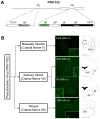
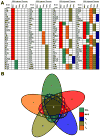

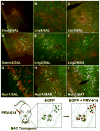
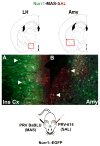
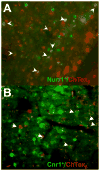
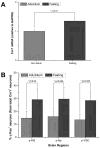
Similar articles
-
Virus-assisted mapping of neural inputs to a feeding center in the hypothalamus.Science. 2001 Mar 30;291(5513):2608-13. doi: 10.1126/science.1056602. Science. 2001. PMID: 11283374
-
Transsynaptic Tracing from Peripheral Targets with Pseudorabies Virus Followed by Cholera Toxin and Biotinylated Dextran Amines Double Labeling.J Vis Exp. 2015 Sep 14;(103):50672. doi: 10.3791/50672. J Vis Exp. 2015. PMID: 26436639 Free PMC article.
-
Injections of the of the α1-adrenoceptor antagonist prazosin into the median raphe nucleus increase food intake and Fos expression in orexin neurons of free-feeding rats.Behav Brain Res. 2017 May 1;324:87-95. doi: 10.1016/j.bbr.2017.02.021. Epub 2017 Feb 14. Behav Brain Res. 2017. PMID: 28212941
-
The alpha-herpesviruses: molecular pathfinders in nervous system circuits.Trends Mol Med. 2008 Mar;14(3):134-40. doi: 10.1016/j.molmed.2007.12.008. Epub 2008 Feb 14. Trends Mol Med. 2008. PMID: 18280208 Free PMC article. Review.
-
New developments in tracing neural circuits with herpesviruses.Virus Res. 2005 Aug;111(2):235-49. doi: 10.1016/j.virusres.2005.04.012. Virus Res. 2005. PMID: 15893400 Review.
Cited by
-
Higher-Order Inputs Involved in Appetite Control.Biol Psychiatry. 2022 May 15;91(10):869-878. doi: 10.1016/j.biopsych.2021.07.015. Epub 2021 Jul 24. Biol Psychiatry. 2022. PMID: 34593204 Free PMC article. Review.
-
Hunger and Satiety Gauge Reward Sensitivity.Front Endocrinol (Lausanne). 2017 May 18;8:104. doi: 10.3389/fendo.2017.00104. eCollection 2017. Front Endocrinol (Lausanne). 2017. PMID: 28572791 Free PMC article. Review.
-
Mapping the vocal circuitry of Alston's singing mouse with pseudorabies virus.J Comp Neurol. 2022 Aug;530(12):2075-2099. doi: 10.1002/cne.25321. Epub 2022 Apr 6. J Comp Neurol. 2022. PMID: 35385140 Free PMC article.
-
Activation of oral trigeminal neurons by fatty acids is dependent upon intracellular calcium.Pflugers Arch. 2012 Aug;464(2):227-37. doi: 10.1007/s00424-012-1116-9. Epub 2012 May 30. Pflugers Arch. 2012. PMID: 22644615 Free PMC article.
-
Hypothalamic melanin concentrating hormone neurons communicate the nutrient value of sugar.Elife. 2013 Dec 31;2:e01462. doi: 10.7554/eLife.01462. Elife. 2013. PMID: 24381247 Free PMC article.
References
-
- Akamatsu W, Okano HJ, Osumi N, Inoue T, Nakamura S, Sakakibara S, Miura M, Matsuo N, Darnell RB, Okano H. Mammalian ELAV-like neuronal RNA-binding proteins HuB and HuC promote neuronal development in both the central and the peripheral nervous systems. Proc Natl Acad Sci USA. 1999;96:9885–9890. - PMC - PubMed
-
- Anderson DJ, Hector MP. Periodontal mechanoreceptors and parotid secretion in animals and man. J Dent Res. 1987;66:518–523. - PubMed
-
- Cahoy JD, Emery B, Kaushal A, Foo LC, Zamanian JL, Christopherson KS, Xing Y, Lubischer JL, Krieg PA, Krupenko SA, et al. A transcriptome database for astrocytes, neurons, and oligodendrocytes: a new resource for understanding brain development and function. J Neurosci. 2008;28:264–278. - PMC - PubMed
Publication types
MeSH terms
Substances
Grants and funding
LinkOut - more resources
Full Text Sources
Molecular Biology Databases

